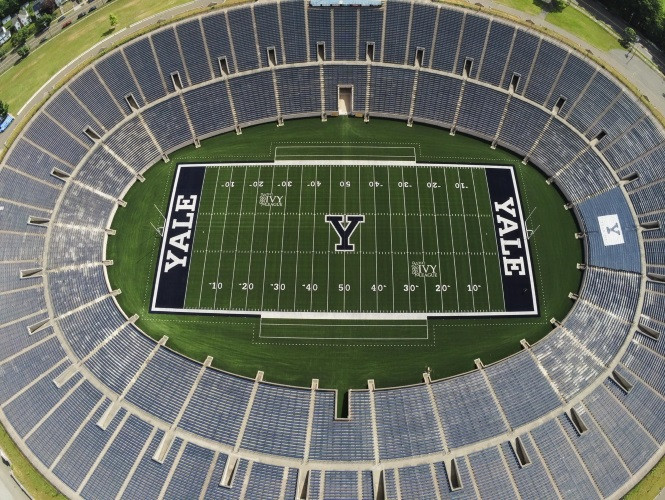Facilities
Yale Bowl
The historic Yale Bowl, with its Class of 1954 Field, is one of the true treasures in American sports and celebrated its 100th birthday in 2014. It was the largest athletic stadium in the world and the first football venue with seating completely surrounding the field when it opened on Nov. 21, 1914, for a game against Harvard.
 The famous Bowl has been a college football landmark ever since, while also hosting National Football League Games, international soccer, lacrosse, tennis, concerts, TV advertisements, movies and the 1995 Special Olympic World Games.
The famous Bowl has been a college football landmark ever since, while also hosting National Football League Games, international soccer, lacrosse, tennis, concerts, TV advertisements, movies and the 1995 Special Olympic World Games.
The Bowl is 930 feet long and 750 feet wide and covers 12.5 acres. Its current seating capacity is 61,446 (it was 70,869 before alterations in 1994 and 2006), and every seat has an unobstructed view of the playing field. The original seating capacity was 60,617 with an undetermined amount of standing room and space to include temporary bleachers.
There have been crowds of over 70,000 on 20 occasions, the most recent on Nov. 19, 1983, for the 100th playing of The Game. The largest crowd to attend a Yale game at the Bowl was 80,000 for Army on Nov. 3, 1923. The 75,300 at the 1981 Yale-Harvard contest was the largest at a sporting event in New England in more than 50 years.
The NFL's New York Giants and Detroit Lions brought professional football to the Bowl for the first time in the summer of 1960. The Giants, who played the New York Jets in a number of memorable exhibition contests during the 70's, used the Bowl as their home field in 1973 and 1974 while Yankee Stadium was renovated.
The design for the Yale Bowl was proposed by Charles A. Ferry, Class of 1871, as a replacement for Yale Field, the 33,000-seat home of the football team from 1884 to 1914. The cost of the final product was $750,000.
Two additions to the legendary Bowl were dedicated during the 2009 season. The Kenney Center, named after four members of the Kenney family - former Yale football players Jerry P. ’63, Brian R. '60, Robert D. '67, Richard L. '71 and Jeffrey S. '93 - is a three-story building attached to the Bowl that houses team rooms and a reception area that opens up to the inside of the Bowl. Jensen Plaza, named after Irving '54, Colin '57, Erik '63 and Mark Jensen '67, includes the names of every Yale football player since 1872 and serves as the grand entrance.
The Sporting News selected the Bowl as one of the 40 best college football stadiums in its book, “Saturday Shrines.” ESPN.com’s list of America’s 100 most important sports venues also included the home of Yale Football.
The playing field, which honors the gifts from the Class of 1954 and became a state-of-the-art synthetic surface in 2019, hosted its 600th collegiate football game on Nov. 23, 2014, when the Elis played Harvard.
Planning for the Bowl, which revolutionized athletic competition in America, began in 1908 when the University reluctantly agreed to the necessity of improving its facilities. However, the University refused to pay for the construction, so the Yale Alumni Board accepted the challenge. A "Committee of Twenty-One" was appointed to oversee the planning, construction and financing. Ground was broken on June 23, 1913, for a stadium that provided safety and perfect viewing for all spectators.
The federal government designated it a national historic landmark in 1987. The original “Bowl” has never lost its allure or mythical status.
|
|
